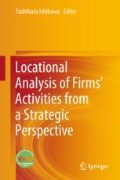Abstract
This paper proves to have a specific law about the size of the exponent for the rank-size model in the population system of the city. It has been said that an exponent of approximately 1 in the empirical evidence takes between 3 from 0.1 with the development of the computer software. Simon (Biometrica, 425–440, 1955) explained the exponent using the probabilistic theory and Krugman (The self-organizing economy, Blackwell, 1996) pointed out that it was difficult for us to understand Simon’s story. Therefore, without using the probabilistic theory, we clarify the implication of the range of the exponent for the rank-size model by supposing the case that migrants concentrate on the city having maximum population in a metropolis in one country, the case that migrants form a new city, and the case that migrants are distributed in proportion to the population of each city.
Access this chapter
Tax calculation will be finalised at checkout
Purchases are for personal use only
References
Allen, P. M. 1997. Cities and Regions as Self-Organizing Systems. Taylor & Francis.
Beckmann, M.J. 1959. City hierarchies and the distributions of city size. Economic Development and Cultural Change 6 (1959): 243–248.
Berry, B. J. L., and F. E. Horton. 1970. Geographic Perspectives on Urban Systems. Prentice Hall.
Christaller, W. 1933. Die zentralen Orte in Suddeutschland, 331S. Jena: Gustav Fischer.
Isard, W. 1956. Location and Space-Economy. M IT Press.
Kozu, H. 2013. Order and Complexity in a City. The Keiei Sogo Kagaku (Journal of managerial research, Japanese). Institute of Managerial Research, Aichi University, pp. 1–24.
Krugman, P. 1996. The Self-Organizing Economy. Blackwell.
Lösch, A. 1940. Die raumlich Ordnung der Wirtschaft. Stuttgart: G. Fisher.
Simon, H. 1955. On a class of skew distribution functions. Biometrica, pp. 425–440.
Zipf, G.K. 1946. The P1P2/D hypothesis on the intercity movement of persons. America Sociological Review 11: 677–686.
Author information
Authors and Affiliations
Corresponding author
Editor information
Editors and Affiliations
Rights and permissions
Copyright information
© 2018 Springer Nature Singapore Pte Ltd.
About this chapter
Cite this chapter
Kozu, H. (2018). City System Based on the Rank-Size Rule. In: Ishikawa, T. (eds) Locational Analysis of Firms’ Activities from a Strategic Perspective. Springer, Singapore. https://doi.org/10.1007/978-981-13-1684-5_6
Download citation
DOI: https://doi.org/10.1007/978-981-13-1684-5_6
Published:
Publisher Name: Springer, Singapore
Print ISBN: 978-981-13-1683-8
Online ISBN: 978-981-13-1684-5
eBook Packages: Economics and FinanceEconomics and Finance (R0)

